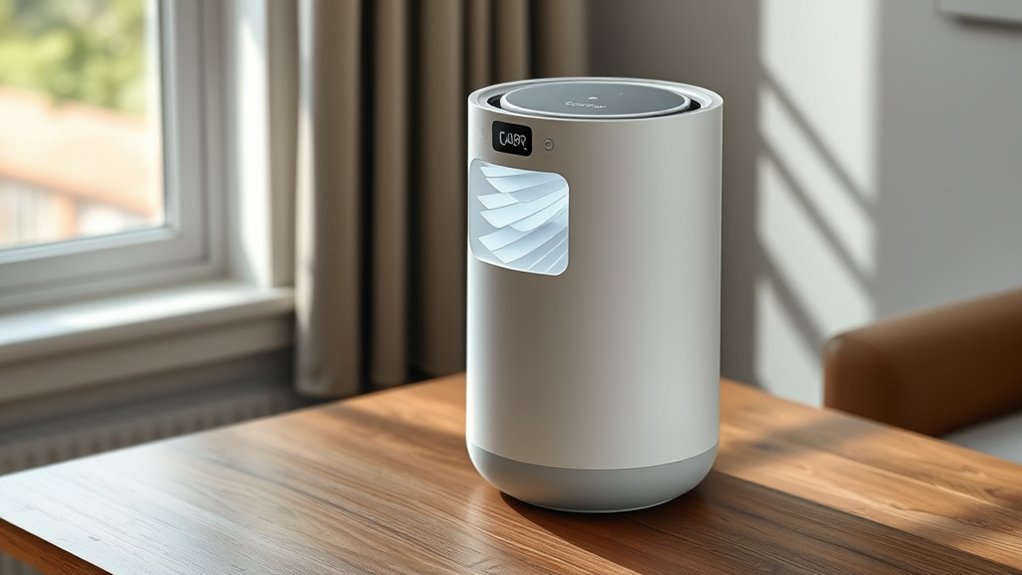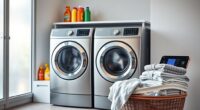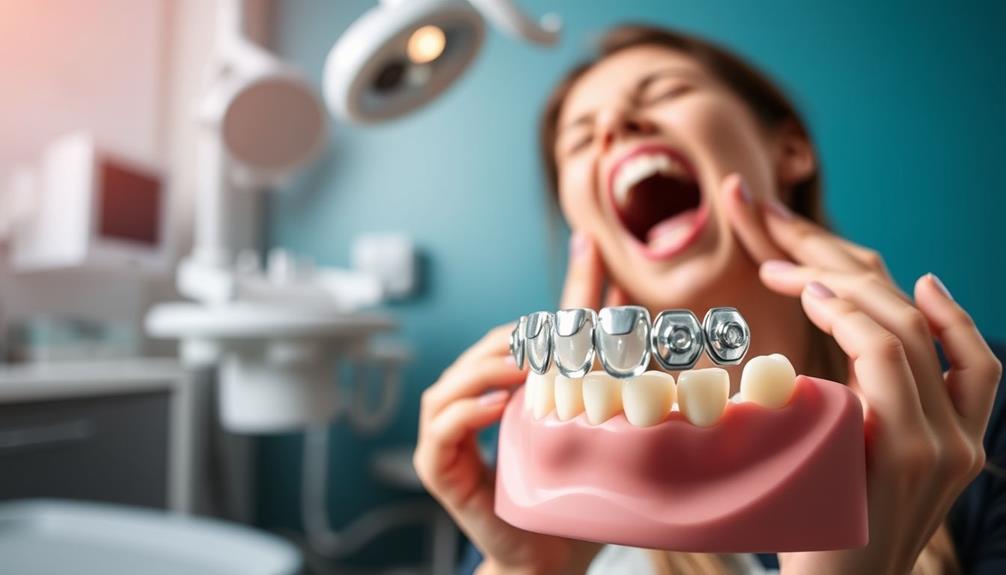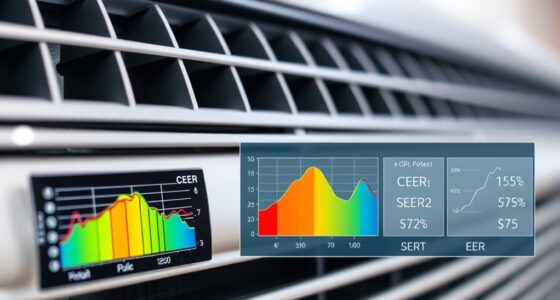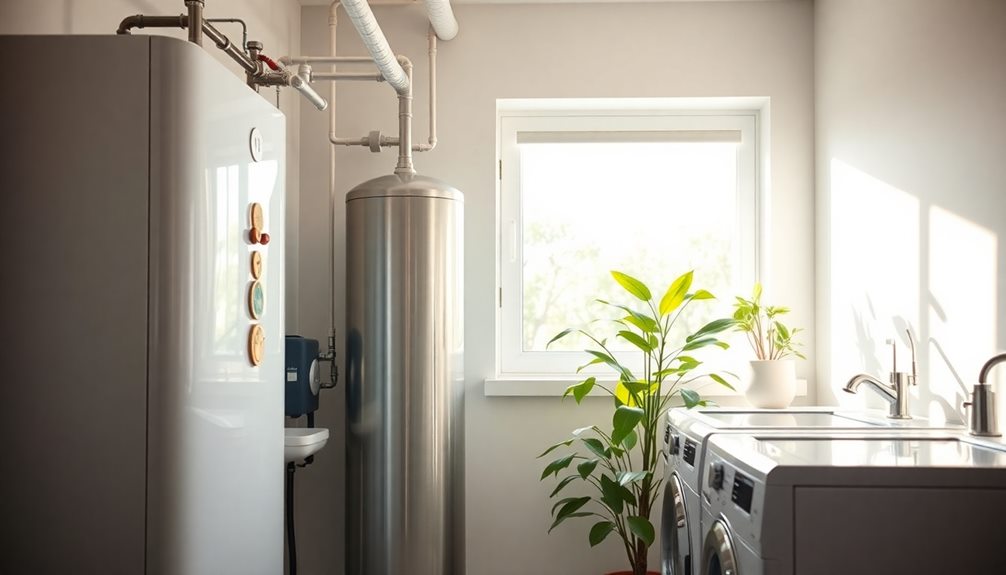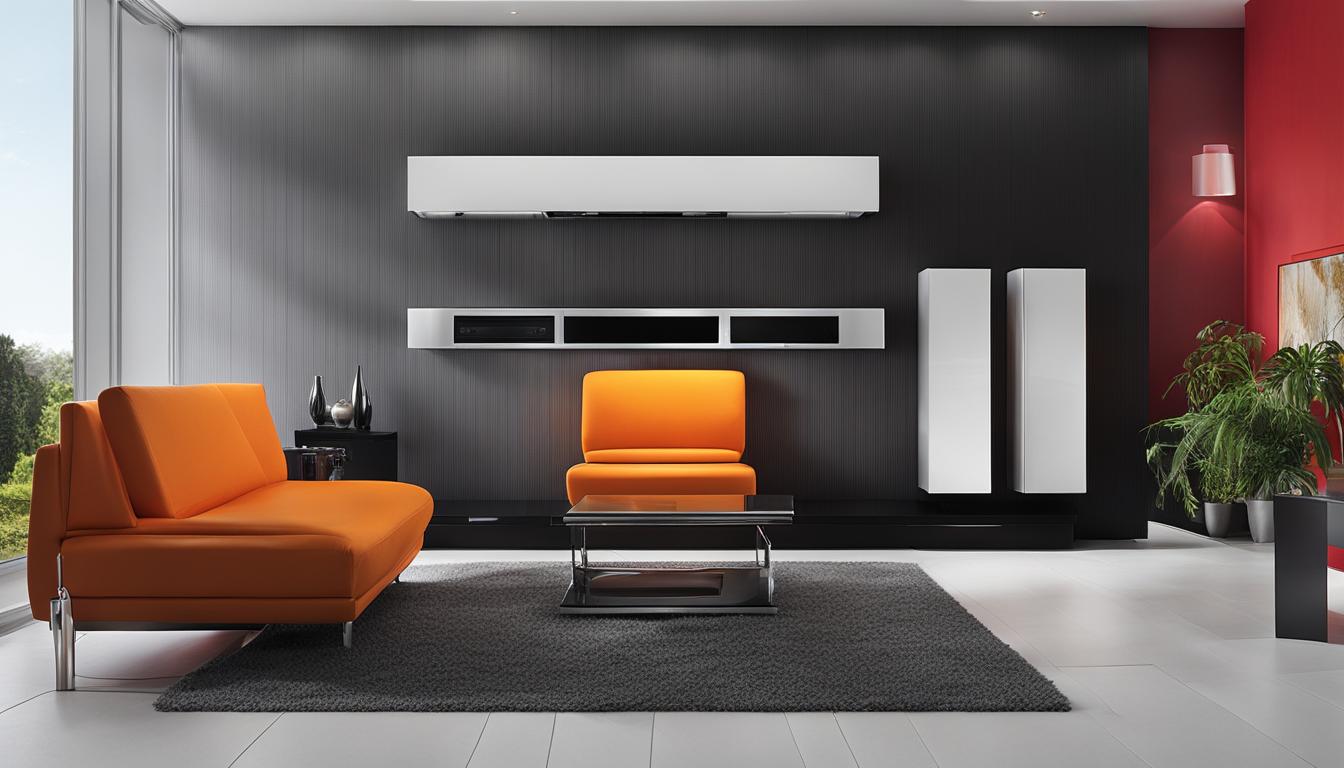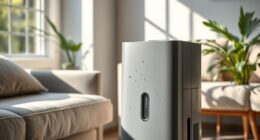Smart air purifiers use CADR ratings to show how quickly they clean the air in your space, with higher ratings indicating faster, more effective performance. Filter grades, like HEPA or MERV levels, determine how well they trap particles and pollutants. Balancing filter efficiency and airflow guarantees ideal results. Certified models and smart features further enhance performance and ease use. For detailed tips on choosing the best purifier, continue exploring how these factors work together.
Key Takeaways
- CADR measures how quickly an air purifier filters pollutants, combining airflow and efficiency, with higher ratings indicating better performance.
- Filter grades like MERV and HEPA determine particle removal efficiency, balancing filtration quality and airflow for optimal operation.
- Certification from authorities such as AHAM verifies CADR ratings and filter performance, ensuring reliable and standardized device claims.
- Smart air purifiers use sensors to monitor air quality in real-time, adjusting CADR and filter settings automatically for optimal purification.
- Choosing the right filter grade and verifying certification ensures effective removal of allergens, pollutants, and maintaining device performance.
What Is CADR and Why Does It Matter?

Ever wondered how to tell if an air purifier is truly effective? That’s where CADR, or Clean Air Delivery Rate, comes in. It measures how much filtered air an air purifier produces per minute, in cubic feet. CADR combines airflow and particle removal efficiency, giving you a clear picture of performance. Ratings are provided separately for smoke, pollen, and dust, representing small, medium, and large particles. A higher CADR means faster, better cleaning, so your indoor air improves quicker. This rating helps you match an air purifier to your room size and compare models easily. Tested under strict standards, CADR ensures you get reliable info. CADR ratings are determined through standardized testing procedures, so you can trust their accuracy. Additionally, understanding filter grades can help you select the most appropriate device for your needs. Remember, a high CADR combined with good filters delivers the pure air your space needs.
How to Calculate the Right CADR for Your Space

To find the right CADR for your space, start by measuring the room’s dimensions to calculate its volume accurately. Then, determine the needed air changes per hour to keep the air clean, usually at least three times per hour. With these numbers, you can choose an air purifier that effectively covers your room’s size and air quality needs. Additionally, consider the filter grade to ensure it matches your specific air purification requirements for allergens or pollutants. Remember that quality fatherhood advice and understanding can also help create a healthier environment.
Room Size and Volume
Calculating the right CADR for your space starts with understanding your room’s size and volume. Measure the length, width, and height in feet or meters, then multiply these to find the volume. For example, a 12 ft × 10 ft × 8 ft room has a volume of 960 cubic feet. To guarantee effective air cleaning, multiply this volume by 3 for the minimum CADR in m³/hr, or convert cubic feet to cubic meters (divide by 35.3). Use the table below to interpret your room characteristics and CADR needs:
| Room Size | Volume Calculation | Recommended CADR |
|---|---|---|
| Small (~200 sq ft) | Length × Width × Height | Lower CADR, desktop models |
| Medium (201-399 sq ft) | Same calculation | Mid-range units |
| Large (400+ sq ft) | Sum of multiple sections | High CADR or multiple units |
Additionally, understanding room volume helps determine the appropriate air purifier for your needs, especially when considering filter grades and their effectiveness in various room sizes.
Air Changes per Hour
Understanding air changes per hour (ACH) helps you gauge how effectively your room’s air circulates and refreshes. To calculate ACH, you need to know your room’s volume and your air purifier’s CADR. The formula is ACH = (CADR x 60) / Room Volume. A higher ACH means better air circulation and improved air quality. To find the right CADR, consider your room size and desired air refresh rate. Additionally, understanding generative AI options can help diversify your investment portfolio during times of economic uncertainty.
How CADR Is Measured and Tested
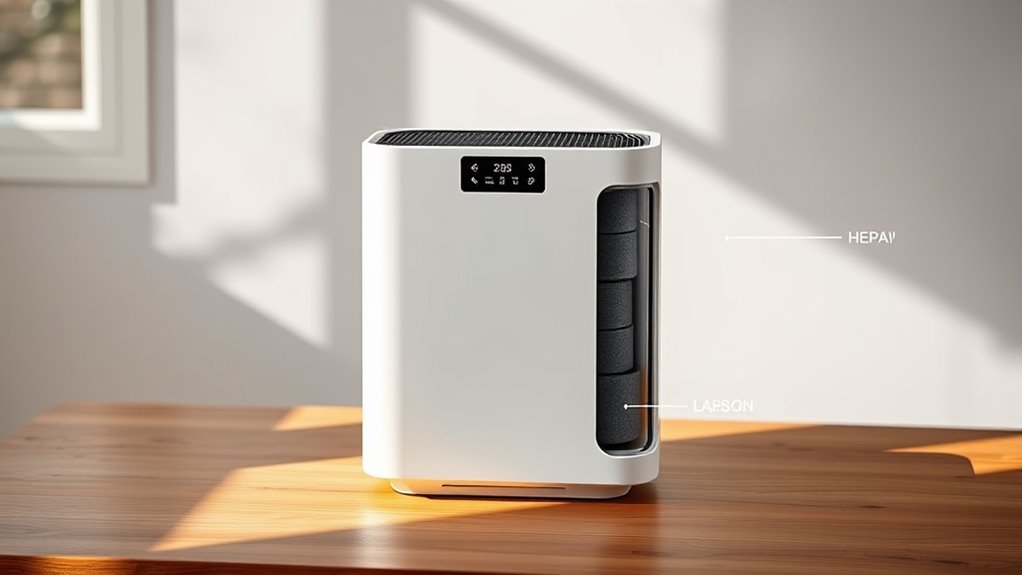
Measuring and testing CADR involves placing the air purifier in a sealed, controlled chamber that simulates a small room, typically around 30 m³. The device is positioned centrally to ensure even air and pollutant distribution. Pollutants such as tobacco smoke, pollen, and dust are injected and mixed thoroughly, with fans circulating the air to homogenize concentrations. The test runs for 20 minutes at maximum fan speed, and particle decay is monitored continuously. To calculate CADR, the purifier’s airflow rate (CFM) is multiplied by its removal efficiency for each pollutant. Natural particle settling is subtracted to isolate the purifier’s performance. Accurate testing procedures ensure the reliability of the results and help consumers compare different air purifiers effectively. Multiple tests for each pollutant ensure accuracy, and the resulting CADR reflects the volume of clean air delivered per minute under controlled conditions. Additionally, high-performance projectors often feature advanced testing standards to ensure reliable air purification performance.
The Role of Filter Grades in Air Purifier Performance

Filter grades play a significant role in determining how effectively your air purifier cleans the air. They directly impact which particles are captured and how well airflow is maintained. Lower-grade filters like MERV 6-8 mainly trap large particles, while MERV 8-10 filters target smaller particles such as pollen and mold spores. Higher grades, like MERV 13 or True HEPA, efficiently remove allergens, pet dander, and some pathogens, enhancing indoor air quality. However, very high-grade filters (MERV 14-20 or Absolute HEPA) can restrict airflow, reducing the purifier’s efficiency and increasing energy use. Choosing the right filter grade involves balancing filtration needs with airflow capacity for ideal performance. Proper filter selection ensures optimal filtration without compromising airflow and energy efficiency. Proper maintenance and timely replacement of filters also play a crucial role in maintaining air purifier performance and ensuring continued effectiveness.
Balancing Filter Efficiency and Airflow for Optimal CADR
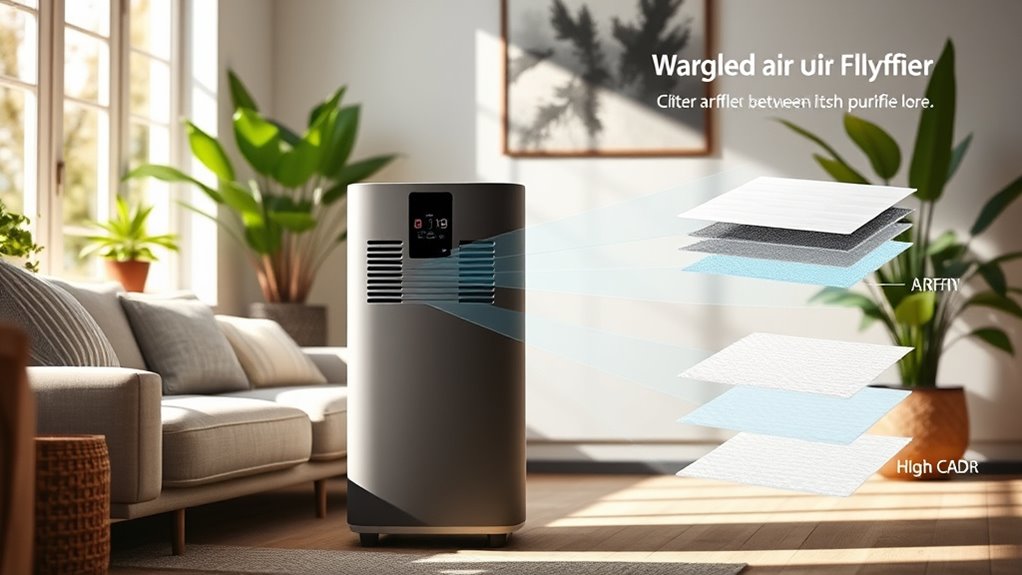
Have you ever wondered how to get the best air quality from your purifier without sacrificing performance? The key is balancing filter efficiency and airflow. Higher-efficiency filters, like HEPA, use denser materials that trap tiny particles but can restrict airflow. Too much restriction lowers the CADR because less air passes through each second. Moderate restriction allows better contact time with the filter, improving particle removal without heavily impacting airflow. Filters with MERV ratings below 9 are ineffective at capturing fine particles, while MERV 11-13 strike a good balance between efficiency and airflow. Using filters designed for your system ensures minimal pressure drop, preventing strain on fans. Regularly replacing filters prevents clogging, maintaining ideal airflow and consistent CADR. Proper maintenance and choosing the right filter grades are essential for optimal air purifier performance, and understanding how filter grades influence both efficiency and airflow is crucial for making the best choice.
Practical Tips for Choosing an Air Purifier Based on CADR
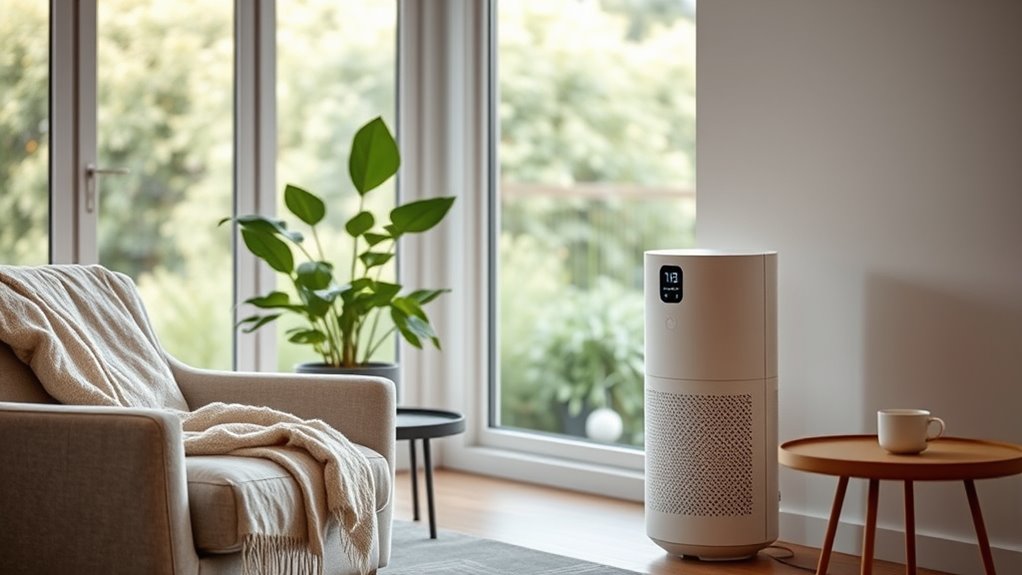
Choosing the right air purifier starts with understanding its CADR ratings and how they relate to your room size. To guarantee effective air cleaning, pick a purifier with a CADR at least two-thirds of your room’s square footage. For smoke-heavy environments, match the smoke CADR to your room size to improve removal speed. Larger rooms or spaces with high ceilings need higher CADR ratings to maintain efficiency. Increasing CADR speeds up air changes, leading to faster pollutant removal. Remember, CADR measures particulate removal, not VOCs or odors, so consider additional filters if needed. Additionally, understanding the special occasions can help in selecting air purifiers that suit specific needs, such as for environments with heightened sensitivities or particular health considerations. It’s also crucial to evaluate the filter grade, ensuring the purifier uses high-quality filters for optimal performance and longevity.
Recent Advances in Filter Technology and Their Impact on CADR

Recent breakthroughs in filter technology are reshaping how air purifiers perform, especially regarding CADR. New HEPA 14 and medical-grade filters feature lower pressure drops, allowing higher filtration efficiency without extra energy or motor strain. High dust capacity filters capture more particles before saturation, extending lifespan and maintaining consistent CADR. Advanced nanomaterials boost filtration efficiency, targeting ultrafine particles better than traditional fibers. Combining activated carbon and carbon nanotube filters enhances gas and VOC removal, broadening filtration scope. Multi-stage designs with up to seven layers achieve removal rates of 99.97% of airborne particles, including allergens. These innovations increase CADR by reducing airflow resistance, stabilizing performance longer, and expanding filtration capabilities. Additionally, filter grades play a crucial role in determining overall purifier effectiveness, guiding consumers toward models that best suit their needs. Furthermore, understanding filter efficiency helps consumers select the most suitable air purifier for their specific air quality concerns.
The Significance of Certification and Standards in CADR Ratings

Certification authorities set the standards that guarantee your air purifier’s CADR ratings are accurate and trustworthy. You shouldn’t rely solely on marketing claims, as certified ratings verify performance across tobacco smoke, dust, and pollen removal. This enforcement helps improve device reliability, giving you confidence that your air purifier works as advertised. Additionally, adherence to cybersecurity measures during the certification process ensures the integrity of performance data. Ensuring standardized testing procedures are followed during certification further guarantees that ratings are consistent and comparable across different devices.
Certification Authority Role
Have you ever wondered who guarantees that the CADR ratings on air purifiers are accurate and trustworthy? Certification authorities play a vital role by overseeing compliance with safety, performance, and environmental standards. They verify that CADR ratings reflect real cleaning capabilities through independent testing. Recognized organizations, like AHAM, certify CADR for dust, pollen, and smoke removal, following strict ANSI/AHAM AC-1 standards. Forsale 100 Certification bodies confirm safety and emission standards. Labels are checked for accuracy and clarity to protect consumers. Certification authorities influence market acceptance and regulatory approval, making sure that your air purifier performs as advertised. Their oversight helps build trust, giving you confidence in the device’s effectiveness and safety. Additionally, they ensure industry standards are maintained, fostering continuous improvement and innovation in air purification technology.
Certification vs. Marketing Claims
Understanding the difference between certified performance and marketing claims is essential when choosing an air purifier. Many products labeled as “HEPA” aren’t independently tested to meet strict standards, and terms like “HEPA-like” are just marketing phrases that don’t guarantee filtration quality. Without a regulatory body overseeing these claims, manufacturers can label filters as “HEPA” without verification, leading to inconsistent effectiveness. Certification ensures that performance claims, including CADR and filter efficiency, are reliable and backed by standards such as UL 900 or EN 1822. Certified CADR ratings and filter grades like MERV or true HEPA confirm the purifier’s ability to remove harmful particles effectively. Relying on certification instead of marketing claims helps you avoid ineffective products and ensures your device performs as promised. Vetted standards and independent testing are crucial for verifying these claims and ensuring the product’s quality.
Impact on Device Reliability
When a device’s CADR ratings are backed by recognized testing standards like ANSI/AHAM AC-1 or GB 18801-2015, you can trust that its performance reflects real-world effectiveness. Certification ensures that CADR values are consistent, repeatable, and comparable across different devices. Devices with reputable marks, such as AHAM Verifide® or ENERGY STAR, have undergone independent verification, reducing the risk of inflated claims. Certification also includes safety checks for electrical hazards and ozone emissions, safeguarding your health. You benefit from increased confidence, knowing the device maintains reliable performance over time. Manufacturers are motivated to uphold quality standards, as non-compliance can lead to decertification or removal from the market. This creates a trustworthy market where performance and safety truly matter. Additionally, industrial design elements inspired by Victorian and steampunk aesthetics can emphasize the durability and craftsmanship associated with certified products, reinforcing their reliability and quality.
How Smart Features Enhance CADR and Overall Air Quality Management

Smart features considerably boost the effectiveness of air purifiers by enabling real-time air quality management. Built-in sensors continuously monitor pollutants like particulate matter, VOCs, and humidity, allowing the device to adjust operation automatically. Adaptive sensor calibration guarantees accurate detection of pollution spikes, prompting the purifier to increase fan speed or purification intensity as needed. Real-time feedback loops enable immediate responses, raising CADR during pollution events to improve air quality quickly. Integration with smartphones and home assistants lets you remotely track indoor air quality and control your purifier. Additionally, smart purifiers optimize airflow by modulating fan speeds based on pollution levels, conserving energy when air quality improves. These features work together to enhance overall air quality management and maintain healthier indoor environments.
Frequently Asked Questions
How Do Smart Sensors Adjust CADR in Real-Time?
You’ll see your smart purifier’s sensors adjust CADR instantly based on real-time air quality data. When pollutants spike, sensors signal the fan to speed up, increasing airflow and purification. As air improves, they slow it down to save energy and reduce noise. This continuous feedback loop keeps your indoor air clean efficiently, adapting automatically to changing conditions without you needing to intervene.
Can a Higher Filter Grade Improve CADR Without Reducing Airflow?
A higher filter grade alone can’t improve CADR without reducing airflow because denser filters tend to block airflow, lowering the overall performance. To maintain or boost CADR with better filters, your device needs engineering solutions like larger surface areas, stronger fans, or multi-stage filtration. These innovations help offset airflow resistance, ensuring that the purifier efficiently captures particles while still delivering a high volume of cleaned air.
What Is the Impact of Multiple Filter Stages on CADR?
Imagine each filter stage as a guardian fighting different pollutants. Multiple filters can enhance overall air cleaning by targeting various contaminants, but they also create resistance like a maze, potentially lowering airflow and CADR. To keep performance high, you need a well-sized fan, proper airflow design, and regular maintenance. When balanced correctly, multiple stages act like a team, boosting purification without sacrificing efficiency.
How Does Room Layout Affect Actual CADR Performance?
Your room layout substantially impacts the actual CADR performance. Furniture, obstacles, and irregular shapes can block airflow, making the purifier less effective than its rating suggests. Placing the device away from corners or behind furniture helps maintain ideal airflow. Open spaces and strategic positioning near pollution sources improve purification. Remember, CADR ratings are based on ideal conditions, so real-world effectiveness depends on how well your room’s layout supports proper air circulation.
Are There Any Risks of Over-Filtering With High CADR Purifiers?
Over-filtering with high CADR purifiers can pose risks, especially since no ozone level is considered safe by the EPA. You might unknowingly increase indoor ozone emissions, which can cause respiratory issues. Additionally, overly efficient filters may remove beneficial microorganisms, and clogged filters could reduce airflow, lowering performance and possibly releasing trapped pollutants back into your air. Regular maintenance helps prevent these risks and keeps your air healthier.
Conclusion
Think of CADR as the heartbeat of your air purifier, guiding you through clear, fresh air. When you choose wisely, it’s like planting seeds of purity that bloom within your space. Balance filter grades and airflow, and let smart features be the guiding stars. Together, they form a rhythm—your personal symphony of clean, healthy air. Trust in these signs, and breathe with confidence, knowing you’ve created a sanctuary from the invisible.
